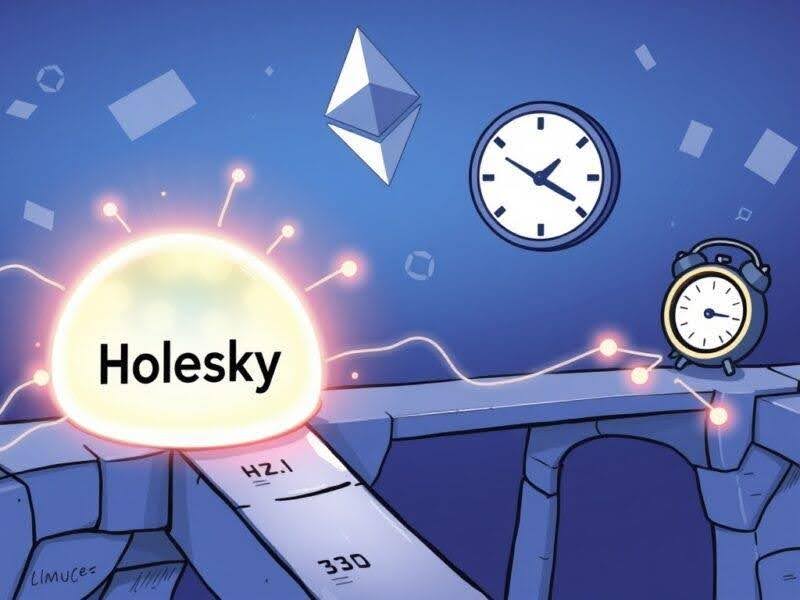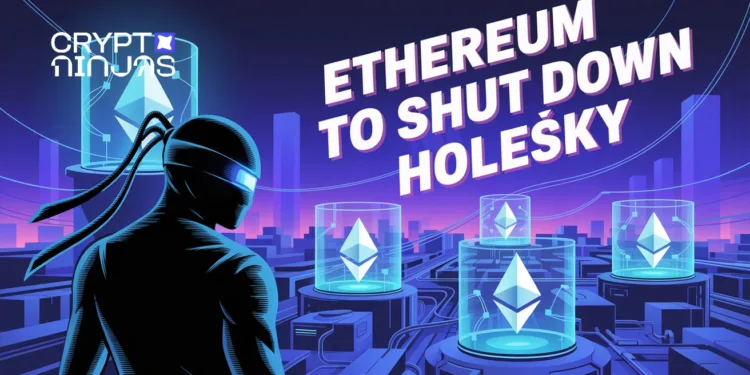Key Takeaways:
- Holešky, Ethereum’s greatest testnet, might be decommissioned two weeks after the Fusaka improve finalizes in September 2025.
- Hoodi will absolutely exchange Holešky as the brand new validator-focused testnet, designed to keep away from the technical points that plagued its predecessor.
- Ethereum now runs 3 specialised testnets: Sepolia (for dApps), Hoodi (for staking), and Ephemery (for brief validator cycles).
Ethereum is formally sunsetting its most formidable Testnet, Holešky, marking a pivotal transition in its testing infrastructure. After almost two years of enabling essential upgrades and scaling experiments, Holešky is being phased out in favor of extra modular and specialised networks.


Holešky Was a Large however Its Time Is Over
The Finish of a Vital Period
Launched in September 2023, Holešky was Ethereum’s largest public Testnet ever, purpose-built to simulate real-world staking circumstances at huge scale. At its peak, it hosted over 1.6 million validators, dwarfing earlier testnets like Goerli and Ropsten.
Holešky was notably concerned in testing upgrades together with:
- Dencun: Aimed toward decreasing transaction prices by way of EIP-4844 (Proto-Danksharding)
- Pectra: Optimized validator efficiency and launched partial withdrawal mechanisms
The identical scale which had made Holešky so spectacular turned, nonetheless, additionally towards it.
Learn Extra: Ethereum Rally Extends, With Solana and Rising Initiatives Following
Why Holešky Needed to Be Retired
Inactivity Leaks and Validator Exit Bottlenecks
In early 2025, Holešky started exhibiting indicators of stress. After the activation of the Pectra improve, a wave of inactivity leaks hit the community. 1000’s of validators went offline, making a huge exit queue that took weeks to course of.
This resulted in:
- Sluggish validator churn, making it unviable to check full validator lifecycle inside any sensible timeline.
- Infrastructure fatigue, as builders struggled to simulate dynamic community habits.
Even after technical restoration, the community had changed into an working bottleneck. It was now not in a position to ship the testing agility essential to help the fast-paced Ethereum roadmap.
Enter Hoodi: The Subsequent-Gen Validator Testnet
Born from Holešky’s Shortcomings
Ethereum revealed Hoodi in March 2025 as an effort to appropriate the deficiencies of Holešky. It options:
- A recent validator set, fixing the legacy exit queue problem
- Constructed-in help for Pectra and upcoming upgrades, together with the Fusaka fork
- A extra resilient structure for long-term staking simulations
Hoodi is created on a merged-from-genesis mannequin that has a extra maintainable infrastructure and fewer historic bugs.
Chainstack and Infura, and different giant infra suppliers, already moved their tooling to make use of Hoodi.
Ethereum’s New Testnet Panorama
Ethereum is now working a smaller set of three testnets which are optimized to meet particular capabilities:
| Testnet | Goal |
| Sepolia | Good contract & dApp growth |
| Hoodi | Validator & staking infrastructure testing |
| Ephemery | Light-weight, reset-every-28-days validator lifecycle testing |
This segmentation improves reliability and ensures that testnets align with developer wants, as a substitute of attempting to serve all functions with a single community.
Fusaka Fork Units the Ultimate Deadline
The Fusaka improve, Ethereum’s subsequent main arduous fork is slated to activate on Holešky in mid-to-late September 2025. Two weeks after it finalizes, all remaining validator nodes on Holešky might be shut down.
After this, “Holešky will now not be supported by shopper, testing or infrastructure groups,” stated the Ethereum Basis in a weblog publish.
Fusaka introduces a number of enhancements together with:
- Improved information availability for rollups
- Distributed validator load
- Decrease transaction latency and higher scalability
It includes 11 Ethereum Enchancment Proposals (EIPs) and is the catalyst to the following stage of Ethereum progress.


What’s Subsequent for Ethereum Testnets?
Holešky closure shouldn’t be solely a closure, however it represents the general Ethereum technique of evolution. In 2025 and additional, it turns into clear:
- Streamlined, modular Testnets
- Quicker iteration cycles
- Cleaner infrastructure
Trying ahead Ethereum is concentrating on the Glamsterdam improve in 2026 which proposes to:
- Halve block time from 12s → 6s
- Separate block validation from execution
- Enhance help for ZK-EVM methods
These strikes are aimed squarely at bettering person expertise and scalability, particularly for rollups – a essential element of Ethereum’s layer-2 ecosystem.
Learn Extra: $291 Million Pulled from Bitcoin, Ethereum ETFs as Inflation Spikes Underneath Trump Tariffs
Ethereum Rallies Amid Infra Shakeup
On the level of writing, ETH trades at roughly $4,395 and continues its latest streak, occasioned by ETF enthusiasm and progress in institutional shopping for.
- A number of publicly traded corporations have added ETH to their treasuries
- The crypto group views Ethereum’s infrastructure shakeup as a maturity sign, relatively than a threat
With Holešky’s chapter closing, Ethereum is getting into a part of precision engineering, changing “massive and hulking” with lean and purpose-built.
















